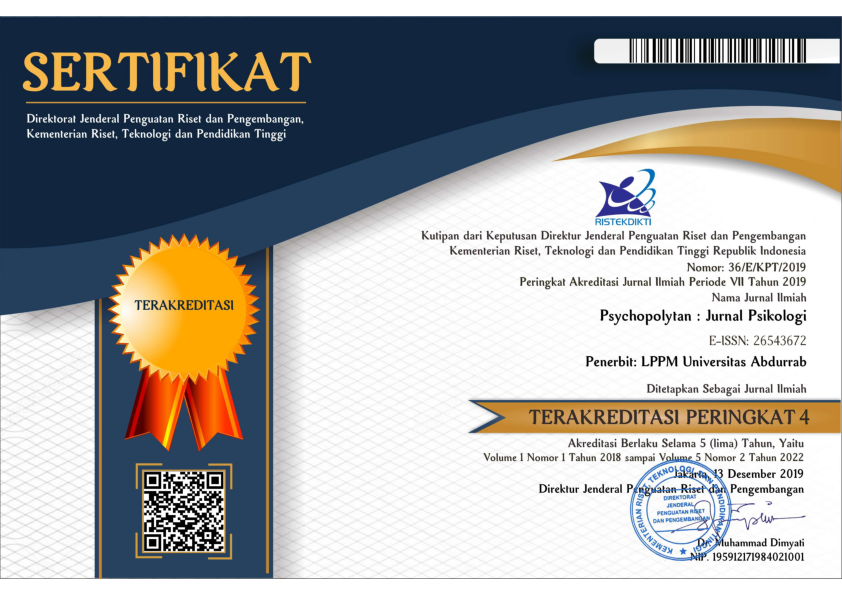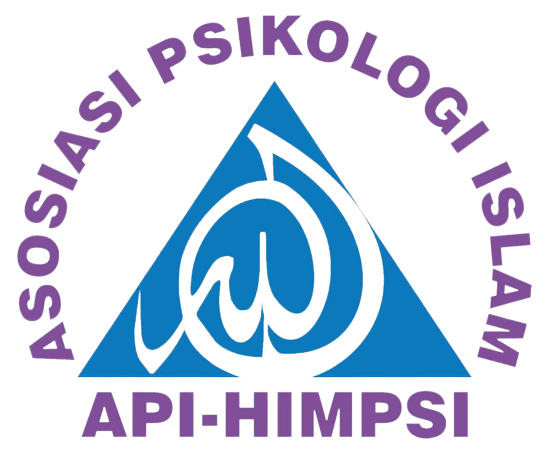Sabar dan Flourishing pada Ibu-ibu Pengajian
Abstract
Flourishing is one of the concepts studied in positive psychology. One of the factors that contributes on flourishing is patience. This research aims to determine the effect of patience on flourishing to mothers who take a part in recitation. The sample was 125 recitation mothers with an average age of 41-50 years old with using snowball sampling technique. This research used Schnitker's (2012) 3-FPQ (Three-Factor Patience Questionnaire) scale with 11 items and Effendy and Subandriyo's (2017) flourishing scale with 23 items. The data analysis technique used is Partial Least Square (PLS) with smartPLS 3.0 software. The results of the analysis show that patience has a positive and significant effect on flourishing with a p value <0.05. The contribution of the influence of the patience variable is able to explain the flourishing variable by 9.9%. Recommendations for future researchers are expected to examine other factors that are assumed to have a greater effect on flourishing, expand research subjects and use qualitative methods to gain a deeper understanding. These findings strengthen other research that show how patience affects flourishing.
References
Aghababaei, N., & Tabik, M. T. (2015). Patience and Mental Health in Iranian Students. Iranian Journal of Psychiatry and Behavioral Sciences, 9(3). https://doi.org/10.17795/ijpbs-1252
Ain, A. Q. (2021). Kontribusi Sikap Sabar Bagi Kesehatan mental di Masa Pandemi Covid-19. Jurnal Tasawuf Dan Psikoterapi, 1–14. http://digilib.uinsgd.ac.id/42595/%0Ahttp://digilib.uinsgd.ac.id/42595/1/Article Asyifa Qurotul Ain.pdf
Akin, A., & Akin, U. (2015). Mediating Role of Coping Competence on the Relationship Between Mindfulness and Flourishing. Suma Psicologica, 22(1), 37–43. https://doi.org/10.1016/j.sumpsi.2015.05.005
Amrullah, A. (2021). Pengajian Artis Dan Fenomena Spiritualitas Youtube. Jurnal Al-Hikmah: Jurnal Dakwah, 15(1), 83–94. http://jurnaliainpontianak.or.id/index.php/alhikmah/article/view/1969
Arif, I. S. (2016). Psikologi Positif : Pendekatan Saintifik menuju Kebahagiaan. PT. Gramedia Pustaka Utama.
Bülbül, A. E., & Izgar, G. (2018). Effects of the Patience Training Program on Patience and Well-Being Levels of University Students. Journal of Education and Training Studies, 6(1), 159. https://doi.org/10.11114/jets.v6i1.2900
Butler, J., & Kern, M. L. (2016). The PERMA-Profiler: A brief multidimensional measure of flourishing. International Journal of Wellbeing, 6(3), 1–48. https://doi.org/10.5502/ijw.v6i3.526
Effendy, N., & Subandriyo, H. (2017). Tingkat Flourishing Individu dalam Organisasi PT X dan PT Y. Fakultas Psikologi Universitas Katolik Widya Mandala Surabaya, 5(1), 1–17. file:///C:/Users/Macbook Pro/Desktop/wellbeing_skripsi/jurnal kajian/nurlaila effendy PERMA.pdf
Ellison, C. G., Boardman, J. D., Williams, D. R., & Jackson, J. S. (2001). Religious involvement, stress, and mental health: Findings from the 1995 Detroit area study. Social Forces, 80(1), 215–249. https://doi.org/10.1353/sof.2001.0063
Ernadewita, & Rosdialena. (2019). Sabar sebagai Terapi Kesehatan Mental. Jurnal Kajian Dan Pengembangan Umat, 3(1). http://jurnal.umsb.ac.id/index.php/ummatanwasathan/article/view/1914
Fauziah, N., Nuuryadien, M., & Mahfud. (2021). Kegiatan Pengajian Rutin Kitab Ta’lim Al-Muta’allim dalam Membina Sikap Ta’dzim Remaja Usia 15-21 Tahun kepada Guru di Masjid Jami’ Al-Ikhlas Desa Sindangmekar Kecamatan Dukupuntang Kabupaten Cirebon. Jurnal Pendidikan Islam, 12(1).
Ghozali, I. (2013). Aplikasi Analisis Multivariate bagi Program SPSS. Badan Penerbitan Universitas Diponegoro.
Hair, J., Black, W., Babin, B., & Anderson, R. (2014). Multivariate Data Analysis. In Pearson New International Edition. SAGE Publications Inc.
Hair, J. F., Hult, G. T. M., Ringle, C. M., & Sarstedt, M. (2013). A Primer on Partial Least Squares Structural Equation Modeling (PLS-SEM). SAGE Publications Inc.
Halimah, L., Fitriyani, C., Nibras, W., Irbah, F., & Hanafi, A. (2019). Sabar Dan Authentic Happiness Pada Anggota Komunitas Khuruj Fisabilillah Di Bandung. Jurnal Psikologi Islam, 6(2), 15–22.
Hamdanah. (2017). Motivasi Ibu-Ibu Mengikuti Pengajian Di Badan Kontak Majelias Taklim (Bkmt) Kota Palangka Raya. Jurnal Transformatif (Islamic Studies), 1(2). https://doi.org/10.23971/tf.v1i2.794
Hidayat, A., Azhar, M., Anis, M., Purnomo, H., & Muliadi, R. (2023). Characteristics of Patience in Parents with Autistic Children: A Phenomenological Study. International Journal of Islamic Educational Psychology, 4(1), 86–101. https://doi.org/10.18196/ijiep.v4i1.17498
Hübner, M., & Vannoorenberghe, G. (2015). Patience and Long-Run Growth. Economics Letters, 137, 163–167. https://doi.org/10.1016/j.econlet.2015.10.011
Huppert, F., & So, T. T. C. (2011). Flourishing Across Europe: Application of a New Conceptual Framework for Defining Well-Being. Social Indicators Research, 110(3), 837–861. https://doi.org/10.1007/s11205-011-9966-7
Jafari, F. (2020). The Mediating Role of Self-Compassion in Relation Between Character Strengths and Flourishing in College Students. International Journal of Happiness and Development, 6(1). https://doi.org/10.1504/ijhd.2020.10030681
Kamaliyah, S., Purwaningsih, I. E., & Ballerina, T. (2020). Koping Religius Kaitannya dengan Subjective Well-Being Santri Pondok Pesantren. Jurnal Spirit Khasanah Psikologi Nusantara, 10(2), 59–72. https://jurnal.ustjogja.ac.id/index.php/spirit/article/view/8212
Kardjono. (2010). Pengendalian Emosi melalui Relaksasi Aktif di Alam Bebas. Jurnal Kepelatihan Olahraga, 2(1), 21–27.
Keyes, C. L. M. (2002). The Mental Health Continuum : From Languishing to Flourishing in Life. Journal of Health and Social Research, 43, 207–222.
Khodarahimi, S. (2013). Hope and Flourishing in an Iranian Adults Sample: Their Contributions to the Positive and Negative Emotions. Applied Research in Quality of Life, 8(3), 361–372. https://doi.org/10.1007/s11482-012-9192-8
Khollda, N. ., & Satria, R. (2021). Peran Kegiatan Pengajian Sebagai Wadah Pelaksanaan Pendidikan Islam Berbasis Masyarakat. Jurnal Pendidikan Tambusai, 5(2), 3825–3830.
Latan, H., & Ghozali, I. (2012). Partial Least Squares Konsep, Teknik dan Aplikasi Menggunakan Program Smart PLS 2.0 M3. Badan Penerbit Universitas Diponegoro.
Lopez, S. J. (2009). The Encyclopedia of positive psychology. In The Clifton Strengths Institute and Gallup (Vol. 1). https://doi.org/10.5860/choice.46-5397
Lubis, M. Z. (2018). Hubungan Sabar terhadap Resiliensi pada Remaja yang Tinggal di Panti Asuhan Sentosa Banjarmasin. Universitas Islam Negeri Antasari.
Murphy, P. E., Ciarrocchi, J. W., Piedmont, R. L., Cheston, S., Peyrot, M., & Fitchett, G. (2000). The Relation of Religious Belief and Practices, Depression, and Hopelessness in Persons with Clinical Depression. Journal of Consulting and Clinical Psychology, 68(6), 1102–1106. https://doi.org/10.1037/0022-006X.68.6.1102
Nasution, M. D. A., Syahara, U., Ananda, R., Romah, M., Siregar, D., Pasaribu, A. H., & Lase, S. H. (2022). Respons Masyarakat dalam Menentukan Manajemen Waktu Pengajian Rutin di Masjid Al Ikhlas Desa Tanjung Selamat. Jurnal Pendidikan Tambusai, 6(1), 274–280.
Park, J., & Roh, S. (2022). Daily spiritual experiences, social support, and depression among elderly Korean immigrants (M. Orrell, R. Allen, & T. Lim (eds.); Vol. 17). Aging & Mental Health. https://doi.org/10.1080/13607863.2012.715138
Prabowo, S. A., & Subarkah, M. Z. (2020). Hubungan Aktivitas Keagamaan dengan Kesehatan Mental Narapidana. Jurnal RAP (Riset Aktual Psikologi Universitas Negeri Padang), 11(1), 35. https://doi.org/10.24036/rapun.v11i1.108509
Rahayu, I. K. (2015). Kesejahteraan Subjektif (Subjective Well-Being) pada Istri Narapidana sekaligus Penderita Kanker Ovarium (Studi Kasus di Desa Ngajum Kabupaten Malang). Universitas Islam Negeri Maulana Malik Ibrahim.
Rahmania, F. A., Anisa, S. N., Hutami, P. T., Wibisono, M., & Rusdi, A. (2019). Hubungan Syukur dan Sabar terhadap Kesejahteraan Subjektif pada Remaja. Psikologika : Jurnal Pemikiran Dan Penelitian Psikologi, 24(2), 155–165. https://doi.org/10.20885/psikologi.vol24.iss2.art6
Rifai, A. (2015). Partial Least Square-Structural Equation Modeling (PLS-SEM) untuk Mengukur Ekspektasi Penggunaan Repositori Lembaga (Pilot Studi di UIN Syarif Hidayatullah Jakarta). Al-Maktabh, 14, 56–65.
Risky, S. N., Puspitasari, R., Saraswati, R. R., & Jakarta, U. N. (2018). Agama dan Kebahagiaan : A Literatur Review. Risenologi KPM UMJ, 3(2).
Ryff, C. D., & Singer, B. (2000). Interpersonal Flourishing: A Positive Health Agenda for the New Millennium. Personality and Social Psychology Review, 4(1), 30–44. https://doi.org/10.1207/S15327957PSPR0401_4
Safaria, T. (2018). Perilaku Keimanan, Kesabaran dan Syukur dalam Memprediksi Subjective Well Being Remaja. Humanitas, 15(2), 127–136.
Sarwono, J., & Narimawati, U. (2015). Membuat Skripsi, Tesis, dan Disertasi dengan Partial Least Square SEM (pls-sem). ANDI.
Schnitker, S. A. (2012). An Examination of Patience and Well-Being. Journal of Positive Psychology, 7(4), 263–280. https://doi.org/10.1080/17439760.2012.697185
Schotanus-Dijkstra, M., Pieterse, M. E., Drossaert, C. H. C., Westerhof, G. J., de Graaf, R., ten Have, M., Walburg, J. A., & Bohlmeijer, E. T. (2015). What Factors are Associated with Flourishing? Results from a Large Representative National Sample. Journal of Happiness Studies, 17(4), 1351–1370. https://doi.org/10.1007/s10902-015-9647-3
Scorsolini-comin, F., Fontaine, A. M. G. V., Koller, S. H., & Santos, M. A. dos. (2013). From Authentic Happiness to Well-Being : The Flourishing of Positive Psychology. Psicologia: Reflexão e Crítica, 26(4), 663–670. https://doi.org/10.1590/S0102-79722013000400006
Sekarini, A., Hidayah, N., & Hayati, E. N. (2020). Konsep Dasar Flourishing Dalam Psikologi Positif the Basic Concept of Flourishing in Positive Psychology. Psycho Idea, 18(2), 1693–1076.
Seligman, M. E. P. (2011). Flourish: A Visionary New Understanding of Happiness and Well-Being. New Year : Free Press.
Subandi. (2011). Sabar: Sebuah Konsep Psikologi. Jurnal Psikologi, 38(2), 215–227.
Sutarjo. (2021). Peran Majelis Taklim Dalam Meningkatkan Pemahaman Keagamaan. Judika (Jurnal Pendidikan Unsika), 9(1), 101–113. https://doi.org/10.35706/judika.v9i1.5238
Syahputra, R. F. (2019). Motivasi Kaum Ibu Mengikuti Pengajian Majelis Taklim Syahidul Ikhlas di Kelurahan Tempel Rejo Kecamatan Curup Selatan. IAIN Curup.
Tuck, I., & Anderson, L. (2014). Forgiveness, Flourishing, and Resilience : The Influences of Expressions of Spirituality on Mental Health Recovery. Informa Healthcare. https://doi.org/10.3109/01612840.2014.885623
Wahyuni, E. N., & Bariyyah, K. (2019). Apakah spiritualitas berkontribusi terhadap kesehatan mental mahasiswa? Jurnal EDUCATIO: Jurnal Pendidikan Indonesia, 5(1), 46. https://doi.org/10.29210/120192334
Yuspendi, Y., Handojo, V., & Handayani, V. (2017). Peran Voluntary Activities dan Coping terhadap Perkembangan Fourishing. Prosiding Temu Ilmiah Nasional X Ikatan Psikologi Perkembangan Indonesia, 1, 190–197.
Yuwono, S. (2010). Mengelola Stres dalam Perspektif Islam dan Psikologi. Psycho Idea, 2.
Copyright (c) 2024 Psychopolytan : Jurnal Psikologi

This work is licensed under a Creative Commons Attribution-NonCommercial-ShareAlike 4.0 International License.
1. Copyright of all journal manuscripts is held by the Psychopolytan : Jurnal Psikologi
2. Formal legal provisions to access digital articles of electronic journal are subject to the provision of the Creative Commons Attribution-ShareAlike license (CC BY-NC-SA), which means that Psychopolytan : Jurnal Psikologi is rightful to keep, transfer media/format, manage in the form of databases, maintain, and publish articles.
3. Published manuscripts both printed and electronic are open access for educational, research, and library purposes. Additionally, the editorial board is not responsible for any violations of copyright law.
licensed under a Creative Commons Attribution-ShareAlike 4.0 International License.
 pdf
pdf
 Abstract views: 73
Abstract views: 73
 downloads: 91
downloads: 91

 :
:







